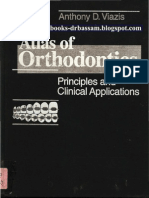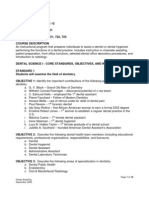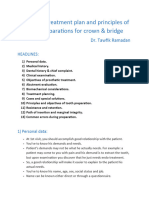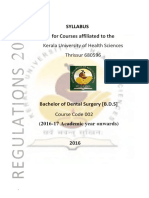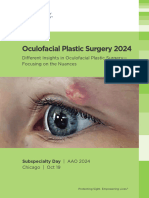0 ratings0% found this document useful (0 votes)
30 viewsPatientcare 1
Patientcare 1
Uploaded by
Samir ElborolosyThis document outlines the patient care responsibilities of a dentist under three sections: I) comprehensive assessment, diagnosis and treatment planning; II) comprehensive treatment; and III) management of medical and dental emergencies, pain and anxiety. Section I describes developing a treatment plan through examination, diagnosis, and consideration of patient goals. Section II covers preventive care, management of periodontal and pulpal diseases, oral surgery, occlusal issues, and restorative work. Section III addresses preventing, recognizing and treating medical emergencies; controlling oral emergencies; and managing pain, anxiety and complications through pharmacological and non-pharmacological methods.
Copyright:
Attribution Non-Commercial (BY-NC)
Available Formats
Download as DOCX, PDF, TXT or read online from Scribd
Patientcare 1
Patientcare 1
Uploaded by
Samir Elborolosy0 ratings0% found this document useful (0 votes)
30 views5 pagesThis document outlines the patient care responsibilities of a dentist under three sections: I) comprehensive assessment, diagnosis and treatment planning; II) comprehensive treatment; and III) management of medical and dental emergencies, pain and anxiety. Section I describes developing a treatment plan through examination, diagnosis, and consideration of patient goals. Section II covers preventive care, management of periodontal and pulpal diseases, oral surgery, occlusal issues, and restorative work. Section III addresses preventing, recognizing and treating medical emergencies; controlling oral emergencies; and managing pain, anxiety and complications through pharmacological and non-pharmacological methods.
Original Title
Patientcare 1
Copyright
© Attribution Non-Commercial (BY-NC)
Available Formats
DOCX, PDF, TXT or read online from Scribd
Share this document
Did you find this document useful?
Is this content inappropriate?
This document outlines the patient care responsibilities of a dentist under three sections: I) comprehensive assessment, diagnosis and treatment planning; II) comprehensive treatment; and III) management of medical and dental emergencies, pain and anxiety. Section I describes developing a treatment plan through examination, diagnosis, and consideration of patient goals. Section II covers preventive care, management of periodontal and pulpal diseases, oral surgery, occlusal issues, and restorative work. Section III addresses preventing, recognizing and treating medical emergencies; controlling oral emergencies; and managing pain, anxiety and complications through pharmacological and non-pharmacological methods.
Copyright:
Attribution Non-Commercial (BY-NC)
Available Formats
Download as DOCX, PDF, TXT or read online from Scribd
Download as docx, pdf, or txt
0 ratings0% found this document useful (0 votes)
30 views5 pagesPatientcare 1
Patientcare 1
Uploaded by
Samir ElborolosyThis document outlines the patient care responsibilities of a dentist under three sections: I) comprehensive assessment, diagnosis and treatment planning; II) comprehensive treatment; and III) management of medical and dental emergencies, pain and anxiety. Section I describes developing a treatment plan through examination, diagnosis, and consideration of patient goals. Section II covers preventive care, management of periodontal and pulpal diseases, oral surgery, occlusal issues, and restorative work. Section III addresses preventing, recognizing and treating medical emergencies; controlling oral emergencies; and managing pain, anxiety and complications through pharmacological and non-pharmacological methods.
Copyright:
Attribution Non-Commercial (BY-NC)
Available Formats
Download as DOCX, PDF, TXT or read online from Scribd
Download as docx, pdf, or txt
You are on page 1of 5
Patient care:
I)Comprehensive Assessment, Diagnosis, and Treatment
Planning .
II) Comprehensive treatment.
III) Medical and dental emergencies, pain and/or
anxiety control.
I) Comprehensive Assessment, Diagnosis, and
Treatment Planning:
Perform a comprehensive diagnostic evaluation based upon )1
the application of scientific principles, and current literature,
.with consultations as appropriate
Obtain and interpret a medical, dental and psychosocial )2
history, including a review of systems as necessary, and
evaluate physical or psychosocial conditions that may affect
.dental management
Identify the patient’s chief complaint/concern and obtain the )3
.associated history
.Perform a clinical examination )4
5) Recognize the need for diagnostic tests and aids .
6) Perform and record the findings of an extra oral,
intraoral, and radiographic examination including physical
assessment of the patient.
7) Interpret the findings from a patient's history, clinical
examination, and radiographic examination and from other
diagnostic tests and procedures.
8) Recognize the normal range of clinical findings and
significant deviations that reflect oral pathology and that require
monitoring, treatment or management.
9) Recognize oral manifestations of systemic disorders, as well
as systemic complications of oral disease, and seeking
Consultations as needed.
10) Combine clinical and supporting data, with individual
patient’s goals and values.
11) Develop a problem list and establish diagnoses. 12)Develop
an appropriate comprehensive, prioritized and sequenced
treatment plan.
13) Modify the treatment plan as required during the course of
treatment and prepare individualized treatment plan
options.
II) Comprehensive Treatment:
1) PROVIDE PREVENTIVE DENTISTRY SERVICE TO
PATIENTS OF ALL AGES ACCORDING TO THEIR
NEEDS:
a) Educate the patient in oral health maintenance and
the prevention of oral diseases.
b) Perform preventive therapies to maximize oral health.
2) MANAGE PATIENTS WITH PERIODONTAL
DISEASES:
a) Recognize periodontal diseases.
b) Perform the initial phase in the treatment of
periodontal diseases.
c) Discuss the rationales of the different surgical
approaches available in the periodontal therapy.
d) Perform supportive periodontal therapy (SPT) after
periodontal treatment.
e) Referring complicated periodontal procedure.
3) PERFORM ORAL SURGICAL PROCEDURES:
a) Achieve local anesthesia for dental procedures and manage
related complications.
b) Perform uncomplicated extractions of teeth.
c) Perform surgical extractions of erupted teeth and
removal of residual root tips.
d) Perform other simple surgical procedures related to
oral soft and hard tissues.
e) Discuss procedures involved in the surgical phase
of dental implants.
f) Recognize patients with chronic orofacial pain and
dysfunction (including temporomadnibular joint
disorders,trauma to the orofacial complex), treat uncomplicated
conditions .
g) referring complicated surgical procedures.
4) PREVENT AND TREAT PULPAL AND PERIAPICAL DISEASES IN
PRIMARY AND PERMANENT TEETH.
a) Perform therapeutic procedures designed to
preserve the vitality of the dental pulp.
b) Perform endodontic therapy.
c) Manage other pulpal disorders of traumatic origin.
d) Assess the indications for endodontic surgical
treatment.
e) Assess success and failure of an endodontic
treatment.
f) Perform pulpotomy in primary teeth.
g) Referring complicated endodontic procedures.
5) MANAGE OCCLUSAL ABNORMALITIES OF
PRIMARY, MIXED AND PERMANENT DENTITIONS:
a) Recognize and manage functional and non-functional
occlusion.
b) Recognize needs for orthodontic treatment.
c) Manage abnormalities of orofacial growth and development
and treat minor orthodontic problems and referring complicated
orthodotic procedures.
d) Design, insert and adjust simple orthodontics
appliances and space maintainers.
6) PROVIDE RESTORATIONS TO REESTABLISH
FORM, FUNCTION AND ESTHETICS TO PATIENTS OF
ALL AGES:
a) Manage dental caries and tooth defects using techniques that
conserve tooth structure and preserve pulp vitality to restore
form and function.
b) Restore teeth with intra or extra coronal
restorations.
c) Restore edentulous spaces with fixed prosthesis.
d) Restore edentulous spaces with removable
prosthesis either complete or partial.
e) Perform esthetic dentistry procedures.
f) Participate in the management of patients with
dental implants needs.
g) Provide protection to the pulp and periodontal
tissues during restorative procedures.
h) Perform, order and evaluate laboratory procedures.
III) Medical and Dental Emergencies, Pain
and/or Anxiety Control:
1) Prevent, recognize and manage medical
emergencies.
2) Control and manage oral emergencies.
3) Anticipate, detect and provide initial treatment and follow-up
management for complications and medical emergencies that
may occur during or as a result of dental treatment.
4) Recognize and manage pain, hemorrhage, trauma and
infection of the orofacial complex.
5) Select and administer or prescribe pharmacological agents in
the treatment of dental patients.
6) Determine the indications and contraindications for the use of
pharmacological agents used in dental practice, their dosages
and routes of administration.
7) Manage patients with pain and/or anxiety using non-
pharmacological methods.
You might also like
- NEWS2 Chart 3 - NEWS Observation Chart - 0 PDFDocument1 pageNEWS2 Chart 3 - NEWS Observation Chart - 0 PDFcicaklomenNo ratings yet
- Complete Dentures Question BankDocument14 pagesComplete Dentures Question Bankkoky1990No ratings yet
- Atlas of Orthodontics - ViazisDocument320 pagesAtlas of Orthodontics - ViazisAdil Houem100% (20)
- Dental AssistantDocument19 pagesDental AssistantMelissa Forbes80% (5)
- Anesthesia Pocket GuideDocument16 pagesAnesthesia Pocket Guidekimchi girl100% (2)
- USCE ObservershipsDocument6 pagesUSCE ObservershipsArsalan Talib Hashmi100% (1)
- 4 5908782355320933019Document8 pages4 5908782355320933019Sagar LodhiaNo ratings yet
- Periodontal Therapy StatementDocument7 pagesPeriodontal Therapy StatementDiana Alexandra100% (1)
- Diagnosis & Failure in Fixed ProsthodonticsDocument8 pagesDiagnosis & Failure in Fixed Prosthodonticsprofadel profadel100% (1)
- Perio-Prog Class 2012Document80 pagesPerio-Prog Class 2012moorenNo ratings yet
- Introduction to Operative Dentistry111Document16 pagesIntroduction to Operative Dentistry111haneenhelmi703No ratings yet
- محاضة رقم 4Document8 pagesمحاضة رقم 4ابو الجودNo ratings yet
- The Treatment Plan: Dr. Omar SolimanDocument36 pagesThe Treatment Plan: Dr. Omar SolimanSamwel EmadNo ratings yet
- Destiny and DevilDocument177 pagesDestiny and DevilSrinivasan NarasimhanNo ratings yet
- Mds - Curriculum (Hust) Tongji Medical CollegeDocument45 pagesMds - Curriculum (Hust) Tongji Medical CollegeMukunda RegmiNo ratings yet
- Principles of ExodontiaDocument25 pagesPrinciples of ExodontiaPankaj JindalNo ratings yet
- Periodontics: Treatment Planning For Patients With Periodontal DiseasesDocument17 pagesPeriodontics: Treatment Planning For Patients With Periodontal Diseasesفاطمة فالح ضايف مزعلNo ratings yet
- Dental Auxiliaries 1Document15 pagesDental Auxiliaries 1faisalalibalochNo ratings yet
- Quality Indicators in Oral SurgeryDocument5 pagesQuality Indicators in Oral Surgerymarryamnasir1009No ratings yet
- Preview Dental AssistantDocument62 pagesPreview Dental AssistantReihan Kaur100% (3)
- الكتاب الاليكترونى-١١Document63 pagesالكتاب الاليكترونى-١١4jnz8ngf4qNo ratings yet
- Mouth Preparation in RPDDocument14 pagesMouth Preparation in RPDDr. Mangala Jyothi KJNo ratings yet
- Lec 1 Diagnosis and Mouth PreparationDocument10 pagesLec 1 Diagnosis and Mouth PreparationAhmad MesaedNo ratings yet
- Diagnosis, Treatment Plan and Principles of Tooth Preparations For Crown & BridgeDocument15 pagesDiagnosis, Treatment Plan and Principles of Tooth Preparations For Crown & BridgemustafaNo ratings yet
- Bds PDFDocument227 pagesBds PDFAiswaryaNo ratings yet
- JimmyDocument23 pagesJimmymohammedgamily278No ratings yet
- The Trimeric Model: A New Model of Periodontal Treatment PlanningDocument5 pagesThe Trimeric Model: A New Model of Periodontal Treatment PlanningNz BebekNo ratings yet
- Six Months of Tissue Healing and Conventional Dentures Procedures Is PreferableDocument3 pagesSix Months of Tissue Healing and Conventional Dentures Procedures Is PreferableTiaraNo ratings yet
- Dentistry As A Science of Health For All IIDocument42 pagesDentistry As A Science of Health For All IIScribdTranslationsNo ratings yet
- E PerioTherapyDocument5 pagesE PerioTherapymirfanulhaqNo ratings yet
- OMP512 Notes Spring 23Document100 pagesOMP512 Notes Spring 23Miran Miran Hussien Ahmed Hassan El MaghrabiNo ratings yet
- Dip in PCDDocument2 pagesDip in PCDToni MaddoxNo ratings yet
- E PerioTherapyDocument5 pagesE PerioTherapyIova Elena-corinaNo ratings yet
- The Tamilnadu DR MGR Medical University Chennai 600 0324699 PDFDocument18 pagesThe Tamilnadu DR MGR Medical University Chennai 600 0324699 PDFsrinandanNo ratings yet
- Periodontology Presentation (Dr. Tanvir)Document36 pagesPeriodontology Presentation (Dr. Tanvir)Dr-Tanvir AhammedNo ratings yet
- Periodontics: Dentistry DepartmentDocument10 pagesPeriodontics: Dentistry DepartmentmahmoodNo ratings yet
- LEC 12 Dental AuxiliaryDocument9 pagesLEC 12 Dental Auxiliaryطيبة نعمانNo ratings yet
- Diagnosis and Treatment Planning - Removable Partial Denture Part-1Document38 pagesDiagnosis and Treatment Planning - Removable Partial Denture Part-1Ahmed AliNo ratings yet
- Bds Syllabus - 240115 - 193609Document111 pagesBds Syllabus - 240115 - 193609poojamb218No ratings yet
- DentistryDocument12 pagesDentistryhoussemzouaoui123No ratings yet
- OrthodonticassessmentDocument44 pagesOrthodonticassessmentナスティオン ファジャルNo ratings yet
- Vinay Pavankumar .K Ii Year Pg. Student Dept of Prosthodontics Maaruti College of Dental SciencesDocument51 pagesVinay Pavankumar .K Ii Year Pg. Student Dept of Prosthodontics Maaruti College of Dental Sciencesاحمد زيد سعيدNo ratings yet
- E PerioTherapyDocument5 pagesE PerioTherapyFerdinan PasaribuNo ratings yet
- NDEB KSAsDocument4 pagesNDEB KSAsR MNo ratings yet
- ZDENT 218 Support Tissue - Course Outline (2017-2018) FINALIZEDDocument11 pagesZDENT 218 Support Tissue - Course Outline (2017-2018) FINALIZEDjdazuelosNo ratings yet
- General Dental Syllabus and Guidance NotesDocument23 pagesGeneral Dental Syllabus and Guidance NotesRajitha DilhanNo ratings yet
- Intern Format DciDocument8 pagesIntern Format DciTejas KulkarniNo ratings yet
- Dental ManpowerDocument38 pagesDental Manpowersashmita rautNo ratings yet
- Clinical Operative I NotesDocument181 pagesClinical Operative I NotesnoursiliemNo ratings yet
- Seminar 6 Preventive Prosthodontics in CD WordDocument29 pagesSeminar 6 Preventive Prosthodontics in CD Wordketaki kunteNo ratings yet
- Implant DentistryDocument11 pagesImplant DentistryDentist ChandraShekarNo ratings yet
- Dental Specialtiesespecilidad Dental - Passive VoiceDocument5 pagesDental Specialtiesespecilidad Dental - Passive VoiceAna Maria Mesones AlvitresNo ratings yet
- 3.list of CompetenciesDocument14 pages3.list of CompetenciesAmithNo ratings yet
- Barsha 562Document34 pagesBarsha 562Pseudo PocketNo ratings yet
- Clinical Diagnosis of Pulpally Involved Teeth - 2020Document15 pagesClinical Diagnosis of Pulpally Involved Teeth - 2020bogdimNo ratings yet
- Nobel Biocare Treatment PlanDocument32 pagesNobel Biocare Treatment PlanSalem RawashdahNo ratings yet
- History Taking and Clinical ExaminationDocument32 pagesHistory Taking and Clinical ExaminationYaser JasNo ratings yet
- Failures in Periodontal Therapy: Review ArticleDocument6 pagesFailures in Periodontal Therapy: Review ArticlezinniaNo ratings yet
- Introduction in Conservative DentistryDocument31 pagesIntroduction in Conservative Dentistryhind shaban100% (1)
- Endodontic J - 2006 - Quality Guidelines For Endodontic Treatment Consensus Report of The European Society ofDocument10 pagesEndodontic J - 2006 - Quality Guidelines For Endodontic Treatment Consensus Report of The European Society ofZelallem AnileyNo ratings yet
- Learning The Art and Science of Diagnosis - JAMADocument2 pagesLearning The Art and Science of Diagnosis - JAMAJose Antonio Tous OlagortaNo ratings yet
- Chorionic Bump in First-Trimester Sonography: SciencedirectDocument6 pagesChorionic Bump in First-Trimester Sonography: SciencedirectEdward EdwardNo ratings yet
- Monograph On Lung Cancer July14Document48 pagesMonograph On Lung Cancer July14PatNo ratings yet
- AAO 2024 Oculoplastic Surgery Subspecialty DayDocument60 pagesAAO 2024 Oculoplastic Surgery Subspecialty DayHalandpep PepNo ratings yet
- Slides Androgen Insensitivity SyndromeDocument18 pagesSlides Androgen Insensitivity SyndromeAsunción AncoNo ratings yet
- Diabetes Mellitus and Heart Failure: Bramantya Andyatma Yeni Octavia Yusri Chizma NajwaDocument31 pagesDiabetes Mellitus and Heart Failure: Bramantya Andyatma Yeni Octavia Yusri Chizma Najwabramantya andyatmaNo ratings yet
- Dialysismachine2 160121151938Document42 pagesDialysismachine2 160121151938Ebrahim Abd El HadyNo ratings yet
- Weight ManagementDocument11 pagesWeight ManagementOscar KatamkoNo ratings yet
- Dyslipidemia - Resident Case FilesDocument5 pagesDyslipidemia - Resident Case FilesTala MahmoudNo ratings yet
- 06ectropion & EntropionDocument17 pages06ectropion & Entropiongideon A. owusuNo ratings yet
- Final Med Cp5400 HandoutDocument7 pagesFinal Med Cp5400 Handoutd00dioNo ratings yet
- Stone DiseaseDocument64 pagesStone DiseaseAmmad ShahidNo ratings yet
- 3.2.2 Drug DeliveryDocument7 pages3.2.2 Drug DeliveryMango LemonNo ratings yet
- Manejo y Tratamiento de Enfermedades Glomerulares (Parte 2) : Conclusiones KDIGODocument25 pagesManejo y Tratamiento de Enfermedades Glomerulares (Parte 2) : Conclusiones KDIGORodrigo Avellaneda CamposNo ratings yet
- House Brackman InglesDocument2 pagesHouse Brackman InglesOscar Cabezas CalderónNo ratings yet
- Prevalence of Glaucoma in India: A Review: Ronnie George, Lingam VijayaDocument5 pagesPrevalence of Glaucoma in India: A Review: Ronnie George, Lingam VijayaprinceamitNo ratings yet
- Dialysis Disequilibrium SyndromeDocument12 pagesDialysis Disequilibrium SyndromeLuis DominguezNo ratings yet
- Euros Core OrgDocument6 pagesEuros Core OrgClaudio Walter VidelaNo ratings yet
- Anatomi Fisiologi HematologiDocument64 pagesAnatomi Fisiologi HematologiNada Putri IrfiantiNo ratings yet
- Emotional DisturbanceDocument37 pagesEmotional DisturbanceRia Joy SanchezNo ratings yet
- Care of WoundsDocument6 pagesCare of WoundsKimpoy Tu-osNo ratings yet
- Acupressure: Acupressure (Chinese - Tui Na)Document4 pagesAcupressure: Acupressure (Chinese - Tui Na)Sanjay SharmaNo ratings yet
- Purulent Inflammations of Serous Cavities: PeritonitisDocument14 pagesPurulent Inflammations of Serous Cavities: PeritonitisSara Abdul RahmanNo ratings yet
- Gastric Outlet ObstructionDocument10 pagesGastric Outlet ObstructionMpanso Ahmad AlhijjNo ratings yet
- Diagnosis and Management of Acute Low Back Pain - American Family PhysicianDocument7 pagesDiagnosis and Management of Acute Low Back Pain - American Family Physicianmagdalena novianaNo ratings yet
- General Survey AssessmentDocument56 pagesGeneral Survey Assessmentdanny_ng080% (1)
- Tle10 q2 Mod3 WM Rev1Document12 pagesTle10 q2 Mod3 WM Rev1jacquelinedanucoNo ratings yet


